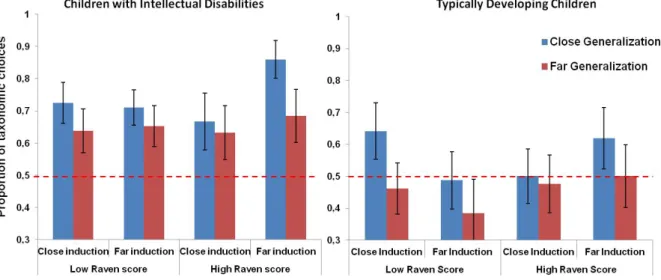Semantic distance in learning and generalization of novel names : the
case of atypically developing children.
___________________________________________________________________________ Arnaud WITT, Université de Bourgogne Jean-Pierre THIBAUT, Université de Bourgogne Annick COMBLAIN, Université de Liège Belgian Association for Psychological Sciences, Annual meeting, May 14th 2019 Abstract: It is generally claimed that lexical development starts at the same mental age (MA) in typically (TD) and atypically developing (ID) children. MA is a good predictor of lexical development, at least for receptive vocabulary, in children with intellectual deficiencies (ID) (Cardoso-Martins & Mervis, 1985 , Barrett & Diniz, 1989 for a review). In ID children, vocabulary size is correlated with mental and chronological age. The acquisition speed of new words in ID children does not equal that of TD children; the two developmental curves gradually separate and the gap between both groups is growing more and more over the years. Comparisons between ID and TD MA matched groups often reveal that the main factors identified in the TD literature play the same role in ID people. Lexical and conceptual development in ID people shows the same typicality effects and the same hierarchy effects. ID lexical development also seems to have the same cognitive underpinnings as TD children (Zampini, Salvi, & D’Odorico, 2015). Typically developping children (TD) often learn the extension of novel words with a limited number of exemplars. There is evidence that the opportunity to compare stimuli is beneficial for learning and generalizing novel names in those children. However, so far, comparison situations have not been studied in children with intellectual disabilities (ID) (Chapman & Kay-Raining Bird, 2012). This is clinically important since they need well-devised learning situations. In this study, we manipulated the role of semantic distance within training stimuli and between training and test stimuli and their influence on taxonomically-based generalization. We hypothesized more difficulties for ID children especially in “larger” semantic distance cases.
24 TD preschoolers and 24 children with mild moderate ID with various etiologies were matched for MA with the RavenCPM. There were 7 close training pairs (i.e., from the same basic category, e.g., two apples), and 7 far pairs (i.e., from the same superordinate category, e.g., an apple and a cherry). Each training pair were introduced as “novel name” “these are buxis”. At test, they had to select “another buxi” between a
perceptually-similar-but- semantically unrelated item (e.g., Christmas ball) and a same-superordinate-but-perceptually-dissimilar category, either close (e.g., banana) or remote (e.g., meat) (see Figure 1).
ID and TD children were split in two groups a High and Low Raven score. A 2 (Learning Distance: close or far) x 2 (Generalization Distance: close or far) x 2 (Group: ID or TD children) x Raven score (Low or High) ANOVA was carried out on the taxonomic choices. It revealed that ID children were better than the matched TD children, suggesting functional lexical learning mechanisms. Even ID low-Raven-scores children, surprisingly, obtained better results than high-Raven-scores TD children. ID children, who were significantly older than TD children, could rely on their more developed world knowledge to learn and extend novel names. Close generalization was also significantly better than far generalization. There was no interaction between Group and the other factors. Interestingly, there was an interaction between Raven score and Learning: High-Raven-scores individuals (HR) outperformed Low-Raven-score participants (LR) in the far learning condition whereas they did not differ on the close learning condition. Also, LR participants were better in the close learning than in the far learning case, while the reverse was true for the HR participants. Importantly, this suggests that LR children had more difficulties to conceptually unify dissimilar training stimuli whereas HR children benefited more from “learning distance”. In sum, what these results show is that ID per se was not the crucial factor here, but rather the level of cognitive functioning which interacted with learning distance. We suggest that ID people can extend their vocabulary in familiar conceptual domain. We interpret our results in terms of cognitive constraints associated with comparison activities which might impact LR children in remote conceptual domains. We predict that ID participants should experience more difficulties with less familiar conceptual domains or with more difficult concepts such as relational concepts, which we currently test.
Figure 1: Our four experimental conditions: In the learning (or induction) phase, “close” pairs were composed of two items from the same basic category; “far” pairs were composed of two items from the same superordinate category. In the test phase, the “close” generalization superordinate (e.g., a banana) came from the same superordinate category, whereas the “far” generalization superordinate (e.g., meat) came from a more distant category. The perceptual matches (e.g., Christmas bauble) were perceptually similar to the learning stimuli but conceptually unrelated. The learning pair stimuli were perceptually similar one to the other. In the test phase, the taxonomic answer was perceptually dissimilar to the learning objects. Figure 2. Mean proportion of taxonomic (correct) choices as a function of population (ID – TD) Raven Score (High-Low), learning (Close-Far), Generalization (Close-Far). Chance was 0.5 Barrett, M. D., & Diniz, F. A. (1989). Lexical development in mentally handicapped children. Language and communication in mentally handicapped people, 3-32.
Cardoso-Martins, C., Mervis, C.B., & Mervis, C.A. (1985). Early vocabulary acquisition by children with Down syndrome. American Journal of Mental Deficiency, 90, 177-184
Chapman RS & Bird EKR. Language Development in Childhood, Adolescence, and Young Adulthood in Persons with Down Syndrome The Oxford Handbook of Intellectual Disability
and Development. DOI: 10.1093/oxfordhb/9780195305012.013.0012
Zampini, L., Salvi, A., & D’Odorico, L. (2015). Joint attention behaviours and vocabulary development in children with Down syndrome. Journal of Intellectual Disability Research,
59(10), 891-901. https://doi.org/10.1111/jir.12191
